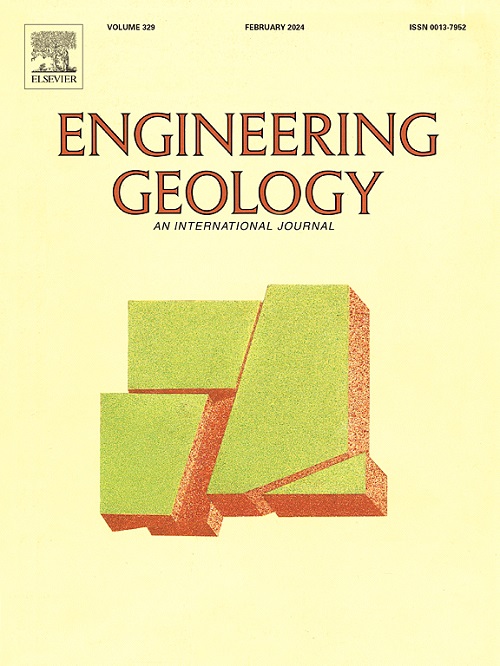含有非塑性细粒的海洋珊瑚砂的应力膨胀行为
IF 6.9
1区 工程技术
Q1 ENGINEERING, GEOLOGICAL
引用次数: 0
摘要
目前对应力膨胀行为的了解主要基于对洁净石英砂的实验,对珊瑚砂的研究有限。特别是,细粒和密度状态对海洋珊瑚砂应力膨胀响应的影响非常值得关注。本研究通过精心控制的土工试验对这些问题进行了系统研究,并进行了相应的讨论和解释。结果表明,在高应力水平下,无论细粒比例和密度状态如何,纯珊瑚砂及其混合物都会持续发生剪切收缩。然而,在中低应力水平下,含有极少细粒的混合物最初会出现剪切收缩,随后出现扩张。峰值状态下的摩擦角(φps)和临界状态下的摩擦角(φcs)、多余摩擦角(φex)和最大膨胀角(ψmax)随着细粉含量的增加而急剧下降。此外,还给出了φps、φcs、φex 和ψmax 的变化下限和上限。φex与ψmax之间的相关性表明,只要细粒含量低于临界值,针对纯砂建立的博尔顿应力膨胀方程仍然适用。此外,灰色关联结果表明,细粒对上述行为的影响最大,其次是密度状态和应力水平。最后,从颗粒柱屈曲的角度探讨了细粒和密度状态影响背后的潜在机制。本文章由计算机程序翻译,如有差异,请以英文原文为准。
Stress-dilatancy behavior of marine coral sand incorporating non-plastic fines
The existed understanding of stress-dilatancy behavior is predominantly based on experiments conducted with clean quartz sand, with limited research focusing on coral sand. Particularly, impacts of fines and density state on stress-dilatancy response of marine coral sand is of significant concern. This work presents a systematic investigation into these issues through meticulously controlled geotechnical tests, coupled with corresponding discussion and interpretation. Results show that at a high stress level, both pure coral sand and its mixtures consistently undergo shear contraction regardless of fines proportion and density state. However, mixtures with minimal fines experience shear contraction initially, followed by dilatancy under a medium-low stress level. Friction angle at peak state () and critical state (), excess friction angle (), and maximum dilatancy angle () decrease powerfully as increasing fines content. Besides, the lower and upper limits of variation for , , concerning were presented. Correlation between and highlights that Bolton's stress-dilatancy equation, developed for pure sand, remains applicable provided that fines content remains below the threshold value. Additionally, gray correlation result suggests that fines post the dominant influence on above behaviors, followed by density state and stress level. Finally, potential mechanism behinds the influences of fines and density state was explored from the view of particle column buckling.
求助全文
通过发布文献求助,成功后即可免费获取论文全文。
去求助
来源期刊

Engineering Geology
地学-地球科学综合
CiteScore
13.70
自引率
12.20%
发文量
327
审稿时长
5.6 months
期刊介绍:
Engineering Geology, an international interdisciplinary journal, serves as a bridge between earth sciences and engineering, focusing on geological and geotechnical engineering. It welcomes studies with relevance to engineering, environmental concerns, and safety, catering to engineering geologists with backgrounds in geology or civil/mining engineering. Topics include applied geomorphology, structural geology, geophysics, geochemistry, environmental geology, hydrogeology, land use planning, natural hazards, remote sensing, soil and rock mechanics, and applied geotechnical engineering. The journal provides a platform for research at the intersection of geology and engineering disciplines.
 求助内容:
求助内容: 应助结果提醒方式:
应助结果提醒方式:


